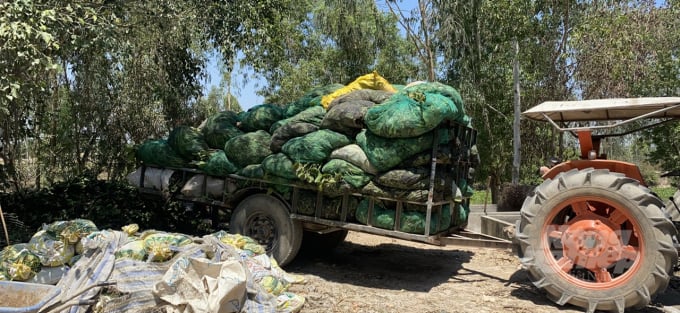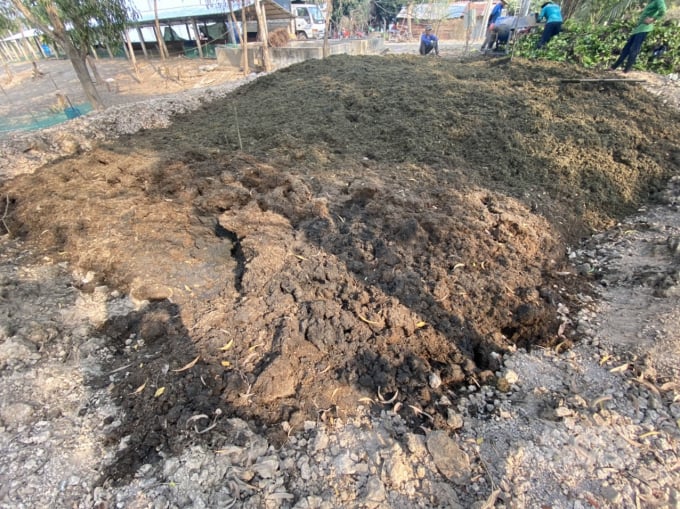November 27, 2025 | 23:47 GMT +7
November 27, 2025 | 23:47 GMT +7
Hotline: 0913.378.918
November 27, 2025 | 23:47 GMT +7
Hotline: 0913.378.918
Located in Dong Thap Muoi, Vinh Hung district is one of the localities with an interlaced canal system. Water hyacinth plants proliferate very quickly there which is blocking the flow and making it difficult to travel and transport goods by waterway, affecting water sources for irrigation.

Cay Trom cooperative organizes to collect water hyacinth from the local canal system to use as raw materials for organic fertilizer production. Photo: Tran Trung.
Meanwhile Cay Trom Cooperative (Hung Dien A commune) considered this a material resource bountiful enough to make organic fertilizer without having to spend much money and labor while still in line with the direction of clean agriculture.
Also with the intention to join hands with the local government and solve the water hyacinth problem, Cay Trom Cooperative has conducted research to produce fertilizer from water hyacinth medium for a cheap price while still assuring in terms of quality and supplies to cooperative members and people in the area.
Mr. Bui Van Tuan, Director of Cay Trom Cooperative, said that each year the cooperative has to import more than 200 tons of organic fertilizer at a price of VND 6,000 /kg. Through mass media the cooperative discovered that recently many local farmers have produced organic fertilizers from agricultural by-products such as straw, straw, even household waste in order to reduce production costs. Since then the cooperative has started its own research to make organic fertilizer from water hyacinth.

Cooperatives apply mechanization to water hyacinth collection in preparation for manure production. Photo: Minh Sang.
According to Mr. Tuan, composting from the stalks of water hyacinth is not difficult: pick up the plant, grind the stalks then cover it using plastic; put the chopped hyacinth on the plastic surface about 20-25cm and then evenly sprinkle the biological product solution to let it soak.
Additional manure can be included in the compost to increase nutrients. Depending on the preparations used, after 1-2 months when it is no longer hot and completely decomposed, the compost pile can be applied to the plants.
“During the incubation process, it is necessary to regularly check the incubation bag so that it is not too hot nor too wet because intense heat can kill microorganisms and reduce protein, while excessive moisture signifies favorable conditions for harmful organisms to grow," said Mr. Tuan.

Water hyacinth carcasses are ground and mixed with probiotics and organic fertilizers before proceeding to the composting process. Photo: Tran Trung.
According to Mr. Tuan, members of the cooperative hesitated at first, in fear that the quality of the compost may affect plant yields. After a period of use and research, many farmers evaluated that the quality of organic fertilizers made from water hyacinth is very good, and their low cost poses an important advantage. Farmers have applied this organic fertilizer on 150 ha of rice at present (50% of the cooperative’s production area).
“I find that organic fertilizers not only help plants limit diseases and increase yields in line with the orientation of organic and sustainable farming but also improve the natural environment in general.
The cooperative sells organic fertilizer to members at a price 30-40% lower than outsiders, helping members reduce the overall cost and increase profits on the same cultivated area. Not only my family but all members of the cooperative feel exhilarated," said Mr. Nguyen Thai Hoa - one of the first members to apply organic fertilizers made from water hyacinth medium into the field.

Having many preeminent factors, organic fertilizers made from water hyacinth medium are now widely applied into the fields by not only cooperative members but also people in the area. Photo: Tran Trung.
The cooperative has self-managed all input services and linked output products to members through partner companies in the past time. When the quality of organic fertilizer made from water hyacinth is confirmed, demand for raw materials is now in constant increase. The cooperative has organized to buy freshwater hyacinth from farmers for VND 2,500 - 3,500/10 kg to improve their income.
“However, due to limited resources and lack of production equipment, the cooperative hopes to receive support from all levels and sectors, contributing to the production and distribution of organic fertilizers to widely develop to the market," said Mr. Tuan.
Having many advantages in raw materials, the promotion of organic fertilizers production and use not only partially solves the problem of water hyacinth but can also be considered a "golden opportunity" to gradually restore the ecosystems that have been abused with chemical fertilizers.
Translated by Samuel Pham

(VAN) According to Mr. Vo Minh Thanh, Director of the Tay Ninh Department of Agriculture and Environment, Resolution 57 has created a new development pathway for the locality, shifting from traditional toward modern agriculture.
/2025/11/26/4909-2-154329_878.jpg)
(VAN) Pearl grouper farming in HDPE cages not only delivers economic efficiency but also contributes to protecting the environment, creating jobs, and promoting marine-based experiential tourism.

(VAN) The model of making a living under the forest canopy through the agroforestry system in Van Son commune, Bac Ninh province, is expected to generate an annual income of approximately VND 30 million/ha.

(VAN) Many enterprises in Can Tho are harnessing natural energy and reducing greenhouse gas emissions in their production processes, thereby contributing to the promotion of a sustainable green transition.
/2025/11/24/3536-2-112800_176.jpg)
(VAN) Dong Nai now has tens of thousands of hectares of forests certified for sustainable management, and this area will continue to be expanded in the coming period.

(VAN) Vinh Ha hamlet (Dai Xuyen commune, Hanoi) is shifting away from small-scale farming as households adopt bioscurity into their breeder chicken models.

(VAN) Heavy rains make aquatic species more vulnerable to disease. Proactive water management and high-tech systems help farmers prevent outbreaks and protect yields.